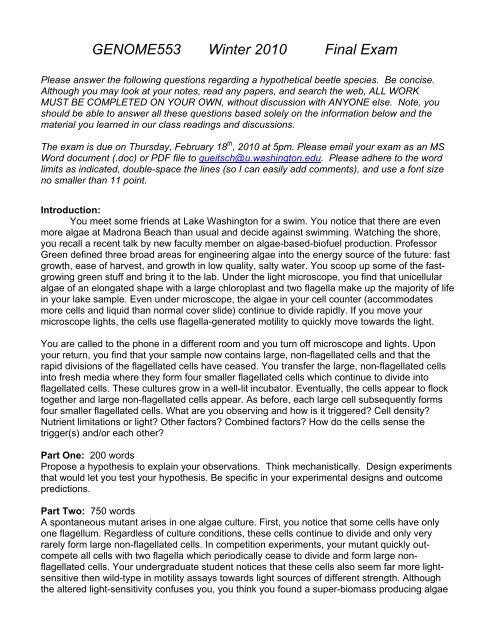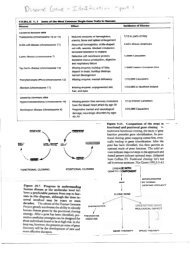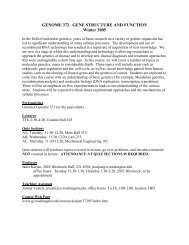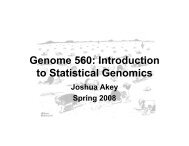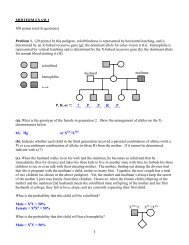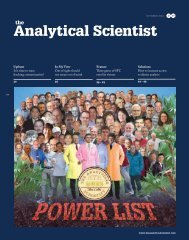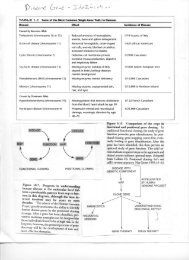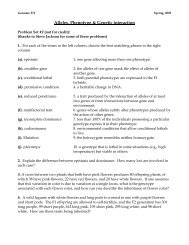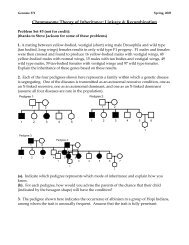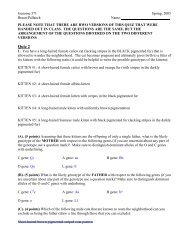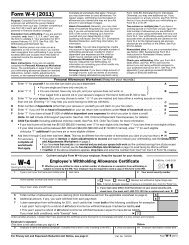Final Exam
Final Exam
Final Exam
Create successful ePaper yourself
Turn your PDF publications into a flip-book with our unique Google optimized e-Paper software.
GENOME553 Winter 2010 <strong>Final</strong> <strong>Exam</strong><br />
Please answer the following questions regarding a hypothetical beetle species. Be concise.<br />
Although you may look at your notes, read any papers, and search the web, ALL WORK<br />
MUST BE COMPLETED ON YOUR OWN, without discussion with ANYONE else. Note, you<br />
should be able to answer all these questions based solely on the information below and the<br />
material you learned in our class readings and discussions.<br />
The exam is due on Thursday, February 18 th , 2010 at 5pm. Please email your exam as an MS<br />
Word document (.doc) or PDF file to queitsch@u.washington.edu. Please adhere to the word<br />
limits as indicated, double-space the lines (so I can easily add comments), and use a font size<br />
no smaller than 11 point.<br />
Introduction:<br />
You meet some friends at Lake Washington for a swim. You notice that there are even<br />
more algae at Madrona Beach than usual and decide against swimming. Watching the shore,<br />
you recall a recent talk by new faculty member on algae-based-biofuel production. Professor<br />
Green defined three broad areas for engineering algae into the energy source of the future: fast<br />
growth, ease of harvest, and growth in low quality, salty water. You scoop up some of the fastgrowing<br />
green stuff and bring it to the lab. Under the light microscope, you find that unicellular<br />
algae of an elongated shape with a large chloroplast and two flagella make up the majority of life<br />
in your lake sample. Even under microscope, the algae in your cell counter (accommodates<br />
more cells and liquid than normal cover slide) continue to divide rapidly. If you move your<br />
microscope lights, the cells use flagella-generated motility to quickly move towards the light.<br />
You are called to the phone in a different room and you turn off microscope and lights. Upon<br />
your return, you find that your sample now contains large, non-flagellated cells and that the<br />
rapid divisions of the flagellated cells have ceased. You transfer the large, non-flagellated cells<br />
into fresh media where they form four smaller flagellated cells which continue to divide into<br />
flagellated cells. These cultures grow in a well-lit incubator. Eventually, the cells appear to flock<br />
together and large non-flagellated cells appear. As before, each large cell subsequently forms<br />
four smaller flagellated cells. What are you observing and how is it triggered? Cell density?<br />
Nutrient limitations or light? Other factors? Combined factors? How do the cells sense the<br />
trigger(s) and/or each other?<br />
Part One: 200 words<br />
Propose a hypothesis to explain your observations. Think mechanistically. Design experiments<br />
that would let you test your hypothesis. Be specific in your experimental designs and outcome<br />
predictions.<br />
Part Two: 750 words<br />
A spontaneous mutant arises in one algae culture. First, you notice that some cells have only<br />
one flagellum. Regardless of culture conditions, these cells continue to divide and only very<br />
rarely form large non-flagellated cells. In competition experiments, your mutant quickly outcompete<br />
all cells with two flagella which periodically cease to divide and form large nonflagellated<br />
cells. Your undergraduate student notices that these cells also seem far more lightsensitive<br />
then wild-type in motility assays towards light sources of different strength. Although<br />
the altered light-sensitivity confuses you, you think you found a super-biomass producing algae
and you call your mutant “TheOne”. You snap some pictures and draw some graphs and visit<br />
Professor Green.<br />
To your dismay, Professor Green has already started to cultivate some of the fast-growing lake<br />
algae and named it “Greenworm greenardii”. On the bright side, he has also isolated some<br />
interesting mutants and knows quite a bit about the algae’s biology and utility for biofuel<br />
production. He tells you that your mutant will be tough to harvest as it no longer responds to the<br />
signal that causes the algae to flock together. You decide to join forces and investigate the<br />
pathways controlling growth, flocculation, and mating. First, you catalogue all mutants, including<br />
your own (“TheOne”).<br />
1. “TheOne” aka Green1: recessive, divides mitotically, fails to flocculate, fails to form zygotes,<br />
highly light-sensitive, rare mating events allow for double mutant analysis, visible phenotype:<br />
has only one flagellum<br />
2. Green2: dominant, flocculates extremely fast after only one or two mitotic divisions, forms<br />
zygotes and flagellated offspring (i.e. mates continuously), light-sensitivity like wild-type, visible<br />
phenotype: 3 flagella<br />
3. Green3: recessive, cells do not flocculate but form zygotes when forced in close proximity,<br />
zygotes form flagellated offspring like wild-type, light-sensitivity like wild-type, visible phenotype:<br />
4 flagella<br />
4. Green4: recessive, divides mitotically, fails to flocculate, fails to form zygotes, light-sensitivity<br />
like wild-type, rare mating events allow for double mutant analysis, visible phenotype: 5 flagella<br />
5. Green5: dominant, cell flocculation and zygote formation is strongly decreased, unlike wildtype<br />
rare zygotes readily form flagellated offspring in dark and light conditions, insensitive to<br />
light in motility assays, visible phenotype: 6 flagella<br />
6. Green6: recessive, cell flocculation and zygote formation as in wild-type, zygotes fail to form<br />
flagellated offspring in the light and dark, rare offspring allows for double mutant analysis,<br />
insensitive to light in motility assays, visible phenotype: large, non-flagellated cells<br />
Your mutants still allow mating and offspring production, albeit at a very low frequency. What<br />
does this indicate? What complications arise for the subsequent double mutant analysis? If you<br />
could not rely on rare mating events, what approach would help you to genetically analyze this<br />
pathway(s)? What complications for double mutant analysis arise from using dominant mutants?<br />
How do you create recessive mutants of Green2 and Green5? How do you confirm that these<br />
mutants are in the same gene? What phenotypes do you expect in the respective recessive<br />
mutants if the original mutant represented a gain-of-function or a loss-of-function mutant?<br />
You decide on double mutant analysis to create a pathway(s) to explain these confusing<br />
phenotypes. Assume no complications due to escapees. Note that the visible flagellum<br />
phenotype is just a marker for your genotype and behaves additively for recessive mutants. This<br />
phenotype is unrelated to the pathway(s) that you study. Professor Green has phenotyped some<br />
double mutants already. Results are shown for an individual non-parental tetrad type (resulting<br />
in 2 cells containing the double mutant and 2 wild-type cells). For simplicity the respective wildtype<br />
cells and additional tetrads are not shown. Please fill in the “?” and predict pathway(s) that<br />
is consistent with your data and Prof. Green’s. Draw the pathway(s) and indicate the nodes<br />
corresponding to the mutants (see also Fig.1). Be specific.
2 3 4 5 6<br />
1 2 ? 1 Unique<br />
phenotype,<br />
cells divide<br />
mitotically,<br />
insensitive<br />
to light, rare<br />
zygotes<br />
readily form<br />
flagellated<br />
offspring in<br />
light and<br />
dark, 7<br />
flagella<br />
2 2 ? 4 ? ?<br />
3 3 ? ? ?<br />
4 4 ? ?<br />
5 5 5<br />
6 6<br />
Unique<br />
phenotype,<br />
cells divide<br />
mitotically,<br />
insensitive<br />
to light, rare<br />
zygotes<br />
mostly fail to<br />
generate<br />
flagellated<br />
offspring<br />
regardless of<br />
light<br />
conditions, 1<br />
flagella<br />
Part Three: 300 words<br />
Your Greenworm isolate is sensitive to high salt in its growth medium. You plan to conduct a<br />
large mutagenesis screen to isolate salt-resistant mutants with wild-type growth rates. Prof.<br />
Green hears of your plans and advices against it – his previous screen for salt-resistant mutants<br />
with wild-type growth failed to yield any mutants. What are possible reasons for this failure?<br />
Why did he not find dominant mutants? If mutagenesis does not work for this particular trait,<br />
what alternative approach could you use to create salt-resistant algae, particularly since your<br />
model organism is small and has a very quick generation time?<br />
While you wait for your alternative approach to yield data, you analyze water samples from<br />
Puget Sound and discover a natural variant of Greenworm that can live in salty water. What<br />
experiments will you conduct to establish that its salt-resistance is genetically based? If so, how<br />
will you determine what these genetic variants are? In the meanwhile, Prof. Green has<br />
established a draft genome sequence of the Greenworm lake strain. In your committee meeting,<br />
Debbie advises you to just sequence the Puget Sound isolate. Do you follow her advice? What<br />
may complicate this approach and how do you circumvent these complications?<br />
Part Four: 500 words<br />
Your cloning efforts reveal that the gene affected in the Green2 mutant encodes a protein with<br />
clear orthology to the alpha component of trimeric G proteins. Recall that your first allele was<br />
dominant. Assuming that your starting mutation was a gain of function, does the Galpha signal<br />
or does the Gbeta signal in this pathway? Now assume the starting mutation was a dominant<br />
negative; does the Galpha signal or does the Gbeta signal in this pathway? How would you
distinguish these possibilities? How would reverse genetics or siRNAs interference help you<br />
with this project? What other experimental approaches may help?<br />
What are the possible functions of Green1, Green3, Green5, and Green6? Recall your double<br />
mutant analysis and pathway predictions and re-interpret in the light of your cloning data. Given<br />
your new-found knowledge, how would you engineer salt-resistant algae that grow fast (i.e. do<br />
not mate), yet flocculate in response to an environmental signal?<br />
Hypothetical Signal Transduction Pathway<br />
signal<br />
?<br />
LR<br />
? ?<br />
7TM GPCR<br />
Galpha/GTP<br />
?<br />
Gbeta/Ggamma<br />
MAPKK<br />
MAPK<br />
TF<br />
Zygote formation (large non-flagellated cells)<br />
? TF TF<br />
TF<br />
TF<br />
?<br />
Flocculation (cells flock together)<br />
Zygote generates four haploid flagellated offspring


